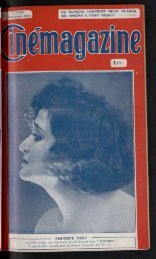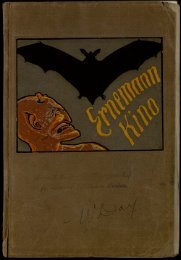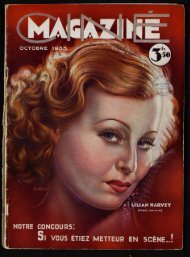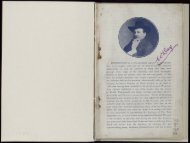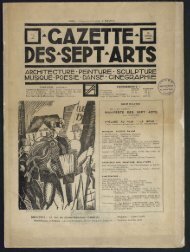Untitled
Untitled
Untitled
Create successful ePaper yourself
Turn your PDF publications into a flip-book with our unique Google optimized e-Paper software.
CHA PTER Vii.<br />
3CO.<br />
JETS may be divided into three broad divisions, the oxycalcium,<br />
the blow-through, and the mixed, to which we have<br />
already referred (pp. 12 and 13, Figs. 7, 8, and 9). The<br />
various features which these jets possess in common have<br />
been considered ; it only remains to discuss those points in<br />
which the types differ. The oxy-calcium, as being the<br />
simplest and the one which yields the least amount of light,<br />
will be first dealt with.<br />
The oxy-calcium jet, as it is generally styled (Fig. 7),<br />
should be called more properly the oxygen-alcohol jet, since<br />
all limelight jets would reasonably conic under the title oxycalcium,<br />
meaning one employing oxygen and lime. This form<br />
of the limelight does not give anything like so much light as the<br />
blow-through jet, or still more as the mixed jet, but is nevertheless<br />
a simple and convenient illuminant, and one much<br />
more brilliant than any oil lamp. It consists of a cylindrical<br />
reservoir, from which a pipe leads to the front of the jet and<br />
terminates in an upright tube containing a cotton wick.<br />
Just behind this is the lime pin. The oxygen is supplied by<br />
means of a tube which is fixed under the reservoir, and<br />
which passes along close to the other tube and bends round<br />
in front of it, terminating in a nozzle. The reservoir is filled<br />
with methylated spirit, the wick-holder being filled with<br />
straight lengths of the loose cotton wick supplied for the<br />
purpose, which should not be packed too closely together, and<br />
the ends of which should stand out about a quarter of an<br />
4<br />
inch above the top of the wick holder. A soft lime having beer<br />
put upon the pin and the lamp lighted, when it is seen thal<br />
the flame is burning properly, the oxygen can be turned slowl)<br />
on until the best light is produced. With this, as indeed with<br />
all jets, it will be found that on turning on the oxygen there is<br />
a point beyond which the light, instead of getting more brilliant,<br />
positively decreases with the increase of oxygen. This is due<br />
to the rush of cold gas, more than is required for the purposes<br />
of combustion, which cools the flame. When, therefore, a jet<br />
is burning badly, it should be seen that it is not getting too<br />
much oxygen, nor, for the matter of that, too little either.<br />
The form of the oxy-alcohol light, shown in Fig. 7, was<br />
designed by Mr. E. G. Wood, and is more elaborate than<br />
many oxy-calcium jets, but the principle in all is the same.<br />
In this case the lime is provided with a shield, which<br />
protects it from the currents of cold air in the lantern, and<br />
the wick chamber is annular or ring-shaped, the oxygen<br />
passing up the centre and being blown into the middle of<br />
the flame. This lime shield can be applied to any other<br />
form of limelight, and its use is advocated by some, who<br />
maintain that more light is obtained with than without it.<br />
The blow-through jet is often spoken of as the "safety,"<br />
and sometimes as the "separate," jet, because, as originally<br />
designed (shown diagrammatically in Fig. 29), the two gases<br />
being kept in separate tubes throughout and only mixed in<br />
the flame itself, by no mischance could either tube contain<br />
Fig. 29. EARLY FORM<br />
OF BLOW-THROUGH Jr.T.<br />
JETS. 39<br />
Fig. 30.<br />
BLOW-THROUGH JET.<br />
a mixture of the two gases. Blow-through jets at the<br />
present time are usually constructed in the manner shown in<br />
Fig. 30, where it will be seen that the jet of oxygen is blown<br />
right into the middle of the coal-gas flame. Such a jet is as<br />
little likely to allow of any mixture in it as Fig. 29, but when



